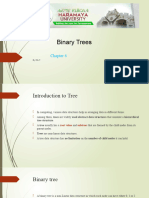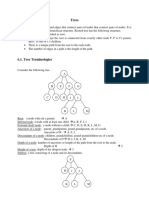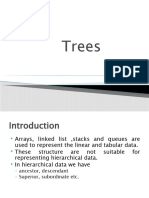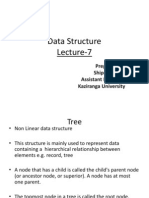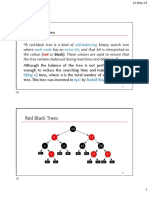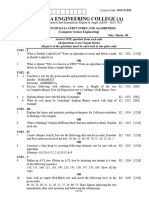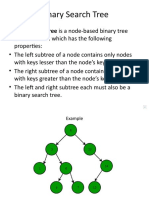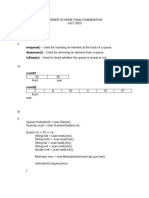Chapter 6: Binary Search Tree (BST) and Heap
6.1 Characteristics of a BST
Binary Search Tree is a binary tree data with the following fundamental properties:
1. The left subtree of a node contains only nodes with keys lesser than the node’s key.
2. The right subtree of a node contains only nodes with keys greater than the node’s key.
3. The left and right subtree each must also be a binary search tree.
4. Each node must have a distinct key, which means no duplicate values are allowed.
The goal of using BST data structure is to search any element within O(log(n)) time complexity.
6.2 Basic Operations on a BST
Any operation done in a BST must not violate the fundamental properties of a BST.
6.2.1 Creation of a BST
Draw the BST by inserting the following numbers from left to right:
70, 50, 40, 90, 20, 20, 95, 99, 80, 85, 75
Here second 20 is ignored as it is duplicate value.
6.2.2 Inserting a Node
While inserting a node to an existing BST, the process is similar to that of creating a BST. We
take the new node data which must not be repetitive or already present in the BST. We start
comparing it with the root node, if the new node data is greater we go towards the right subtree
of the root, if smaller we go towards the left subtree. We keep on going like this until we find a
100
�free space, and then make a node using the new node data and attach the new node at the
vacant place. Note that, after insertion, a balanced BST may become unbalanced and
therefore any searching operation done on it may take a lot longer than O(log(n)). We have to
balance the tree if it becomes unbalanced.
6.2.3 Removing a Node
3 possible cases can occur while deleting a node:
1. Case 1 | No subtree or children: This one is the easiest one. You can simply just delete
the node, without any additional actions required.
2. Case 2 | One subtree (one child): You have to make sure that after the node is deleted,
its child is then connected to the deleted node's parent.
3. Case 3 | Two subtrees (two children): You have to find and replace the node you want to
delete with its leftmost node in the right subtree (inorder successor) or rightmost node in
the left subtree (inorder predecessor).
Here deletion of 99 falls under case 1, deletion of 40 falls under case 2, and deletion of 90, 70
and 75 fall under case 3. While deleting 75, we replaced 75 with its leftmost child from its right
subtree, 80. After that 85 was put in the 80's previous place.
Note that, after deletion, a balanced BST may become unbalanced and therefore any
searching operation done on it may take a lot longer than O(log(n)). We have to balance the tree
if it becomes unbalanced.
101
�6.3 Balanced vs Unbalanced BST
If the height difference between left and right subtree of any node in the BST is more than one, it
is an unbalanced BST. Otherwise, it is a balanced one. In a balanced BST, any searching
operation can take upto O(log(n)) time complexity. In an unbalanced one, it may take upto O(n)
time complexity, which renders the usage of BST obsolete. Therefore, we should only work with
balanced BST and after conducting any operation on a BST, we must first check if it became
unbalanced or not. If it does become unbalanced, we have to balance it.
How to convert an unbalanced BST into a balanced BST?
I. Traverse given BST in inorder and store result in an array. This will give us the
ascending sorted order of all the data.
II. Now take the data in the (size//2) position in the array and make it the root. Now the left
subtree of the root will be all the data residing in from 0 to (size//2)-1 positions of the
array. The right subtree of the root will be all the data residing in from (size//2)+1 to
(size-1) positions of the array.
III. Now again choose the middlemost values from the left subtree and right subtree and
connect these to the root. Keep on repeating the process until all the elements of the
array have been taken.
102
�6.4 BST Coding
6.4.1 Creating a BST / Inserting a Node
Pseudocode
FUNCTION insert(node, key):
IF node IS NULL:
RETURN new Node(key)
IF key < node.key:
node.left = insert(node.left, key)
ELSE IF key > node.key:
node.right = insert(node.right, key)
RETURN node
6.4.2 BST Traversal: Pre-order, In-order, Post-order
Pre-Order In-Order Post-Order
function preorder(root) function inorder(root) function postorder(root)
if root is null if root is null if root is null
return return return
print root.data inorder(root.left) postorder(root.left)
preorder(root.left) print(root.data) postorder(root.right)
preorder(root.right) inorder(root.right) print(root.data)
6.4.3 Searching for an element
FUNCTION search(node, key):
IF node IS NULL:
RETURN False
IF node.key == key:
RETURN True
IF key < node.key:
RETURN search(node.left, key)
ELSE:
RETURN search(node.right, key)
103
�6.4.4 Removing a Node
FUNCTION deleteUsingSuccessor(node, key):
IF node IS NULL:
RETURN NULL
IF key < node.key:
node.left = deleteUsingSuccessor(node.left, key)
ELSE IF key > node.key:
node.right = deleteUsingSuccessor(node.right, key)
ELSE:
// Node with only one child or no child
IF node.left IS NULL:
RETURN node.right
ELSE IF node.right IS NULL:
RETURN node.left
// Node with two children:
// Get inorder successor (smallest in the right subtree)
successor = findMin(node.right)
node.key = successor.key
node.right = deleteUsingSuccessor(node.right, successor.key)
RETURN node
FUNCTION findMin(node):
WHILE node.left IS NOT NULL:
node = node.left
RETURN node
FUNCTION deleteUsingPredecessor(node, key):
IF node IS NULL:
RETURN NULL
IF key < node.key:
node.left = deleteUsingPredecessor(node.left, key)
ELSE IF key > node.key:
node.right = deleteUsingPredecessor(node.right, key)
ELSE:
// Node with only one child or no child
IF node.left IS NULL:
RETURN node.right
ELSE IF node.right IS NULL:
RETURN node.left
// Node with two children:
// Get inorder predecessor (largest in the left subtree)
104
� predecessor = findMax(node.left)
node.key = predecessor.key
node.left = deleteUsingPredecessor(node.left, predecessor.key)
RETURN node
FUNCTION findMax(node):
WHILE node.right IS NOT NULL:
node = node.right
RETURN node
6.4.5 Balancing BST
FUNCTION storeInorder(node, array, index):
IF node IS NULL:
RETURN index
index = storeInorder(node.left, array, index)
array[index] = node.key
index = index + 1
index = storeInorder(node.right, array, index)
RETURN index
FUNCTION buildBalancedBST(array, start, end):
IF start > end:
105
� RETURN NULL
mid = (start + end) / 2
node = new Node(array[mid])
node.left = buildBalancedBST(array, start, mid - 1)
node.right = buildBalancedBST(array, mid + 1, end)
RETURN node
FUNCTION balanceBST(root):
size = countNodes(root)
array = new Array of size
storeInorder(root, array, 0)
RETURN buildBalancedBST(array, 0, size - 1)
106
�6.5 Heap
A heap is an abstract data type (ADT) used for storing values. It is visually represented as a
special binary tree, but its underlying data structure is an array. Arrays enable random access
via indices, making parent and child lookups straightforward. The tree structure makes heaps
intuitive to visualise and manipulate with pen and paper, which we will explore further.
Let’s break down this “special tree”:
A heap must be a complete binary tree and must satisfy the heap property.
In the previous chapter, we studied queues, which follow the FIFO (First In, First Out)
principle. If we want to implement a priority queue—which maintains the FIFO order based on
priority—a heap is the ideal underlying data structure.
6.5.1 Heap Property
A heap is a specialised binary tree that satisfies the heap property and can be of two types:
max-heap or min-heap. Unless otherwise specified, a heap refers to a max-heap in this course.
● In a max-heap, for every node i > 1, the value of the parent node satisfies:
A[Parent(i)] ≥ A[i].
The maximum element is at the root.
● In a min-heap, for every node i > 1, the value of the parent node satisfies:
A[Parent(i)] ≤ A[i].
The minimum element is at the root.
A heap can be either a max-heap or a min-heap, but not both simultaneously.
Heap as an array:
A heap is a complete binary tree that can be efficiently represented using an array, eliminating
the need to store edges explicitly.
● For a node at index i:
○ Parent: ⌊i/2⌋
○ Left child: 2i
○ Right child: 2i + 1
Similar to binary search tree (BST) conventions, heap indexing starts at 1. While the tree
structure aids in visualisation, the underlying data structure used in programming is a simple
array. This array-based representation allows constant-time access to parent and child nodes.
107
� The above tree is a heap. Below is the array representation of the above heap.
1 2 3 4 5 6 7 8 9 10 11 12
X T O G S M N E R Y Z C
Benefits of Using an Array for Heap Instead of a Linked List
Arrays provide random access to elements via indices, allowing direct access to any element by
its index. This makes finding a parent or its children straightforward.
In contrast, a linked list is sequential. To locate a specific element, you must traverse the list
node by node, as it does not support random access like arrays do. Additionally, representing a
tree using linked lists requires three references per node: one each for the parent, left child, and
right child.
6.5.2 Operations on Heap
1. max-heapify(A, i): Ensures the max-heap property of the array A, starting at node i. Also
known as the “sink” operation, as it sinks smaller elements down the tree.
2. heap-increase-key(A, i, key): Increases the value of the element at node i to key and
restores the max-heap property of A by moving larger elements upward. Also known as
the “swim” operation, as it moves larger elements up the tree.
3. max-heap-insert(A, key): Inserts key into the heap A, maintaining the max-heap property.
4. get-maximum(A): Returns the element with the largest key in the heap.
5. heap-extract-max(A): Extracts and returns the largest element from the heap A,
maintaining the heap property.
6. build-max-heap(A): Builds a max-heap from an unordered array A.
7. Heapsort (A): Sorts the elements in array A using heap operations.
6.5.2.1 max-heapify() / Sink():
This operation ensures the max-heap property for the subtree rooted at node i. It is also known
as the "sink" operation because it moves smaller elements down the tree. The precondition for
this operation is that the subtrees rooted at the left and right children of i are already
max-heaps. After executing max-heapify(A, i), the subtree rooted at i will satisfy the max-heap
108
�property, where the value at i is greater than or equal to its children, and both subtrees remain
max-heaps.
Note: Image from Cormen, Leiserson, Rivest, Stein. Introduction to Algorithms, 3rd edition, MIT
Press, 2009.
In the figure above, (a) shows the result of calling max_heapify() on index 2, which contains the
value 4. Since 4 is smaller than both of its children, we compare the values of the children. The
largest child is 14, located at index 4. Therefore, in (b), the values at index 2 and index 4 are
swapped.
Next, max_heapify() is called on index 4, where the value is now 4. Since 4 is smaller than its
right child at index 9, which has the value 8, the values at index 4 and index 9 are swapped.
This is shown in (c).
Time Complexity: The operation has a time complexity of O(log n), as it may require traversing
the height of the tree in the worst case.
Pseudocode:
function max-heapify(heap, index):
size = size of heap
largest = index
left = 2 * index + 1
right = 2 * index + 2
if left < size and heap[left] > heap[largest]:
largest = left
if right < size and heap[right] > heap[largest]:
109
� largest = right
if largest != index:
swap heap[index] with heap[largest]
max-heapify(heap, largest)
6.5.2.2 Heap_Increase_Key() / swim():
The heap-increase-key(A, i, key) operation increases the value of the element at index i to key
and restores the max-heap property by moving the updated element upward through the
heap. This process, known as the "swim" operation, repeatedly compares the updated node
(n) with its parent and swaps them if the parent is smaller. This continues until n is no longer
greater than its parent or it becomes the root. The operation ensures that the max-heap
structure is maintained after increasing a key.
After the swim() operation, the Heap will look like this:
110
�Time Complexity: The best-case time complexity of heap-increase-key is O(1) when the
new key is already in the correct position. The worst case is O(log n), occurring when the
updated node must "swim" up to the root. Thus, the overall time complexity is O(log n).
6.5.2.3 max-heap-insert()
In a max-heap, insertion is performed by placing the new element at the next available
position—i.e., at the end of the array (heap-size + 1), maintaining the complete binary tree
structure. Initially, a placeholder value (e.g., -∞) is inserted, and then the actual key is set using
heap-increase-key(), which adjusts the position of the new key by moving it upward (swim) until
the max-heap property is restored. This ensures that the largest element remains at the root.
1. Original heap creation from the given array 2. Since MAX-HEAP-INSERT(A,10) is called,
we append a node assigned value −∞
A=⟨ 15, 13 , 9, 5, 12, 8, 7, 4, 0, 6, 2, 1, NONE⟩
3. Update the key value of the new node. 4. Update the key value of the new node.
5. Since the parent key is smaller than 10, the nodes
are swapped. (Swim up)
111
�Pseudocode:
Function heap-increase-key(A, i, key)
if key < A[i]
error "new key is smaller than current key"
A[i] = key
while i > 1 and A[parent(i)] < A[i]
exchange A[i] with A[parent(i)]
i = parent(i)
Function parent(index):
return index // 2
Function max-heap-insert(A, key):
heap-size[A] = heap-size[A] + 1
A[heap-size[A]] = -∞
heap-increase-key(A, heap-size[A], key)
6.5.2.4 get_maximum()
Returns the element with the largest key from the max-heap A.
Time Complexity: O(1) (The maximum element is always at the root: A[1]).
6.5.2.5 Heap-extract-max ()
In a heap, you cannot delete an element randomly. Deletion is done by replacing the root with the
last element in the heap, which may break the heap property. The heap will need to be restored
by "sinking" the new root to its correct position.
Initial Max Heap: [30, 20, 15, 7, 10, 5]
30
/ \
20 15
/ \ /
7 10 5
Step 1: Swap root (30) with last element (5), then delete the last element.
After swap: [5, 20, 15, 7, 10] (heapify to follow)
5
/\
20 15
/ \
7 10
Step 2: Call max-heapify from index 1 (heapify down).
112
�After heapify:
20
/ \
10 15
/
7
Final Heap: [20, 10, 15, 7, 5]
Time Complexity: heap-extract-max() has a time complexity of O(log n) due to the
max_heapify() operation, which may traverse the height of the tree in the worst case.
Pseudocode:
function get_maximum(A):
if heap is empty:
return error
return A[1]
function heap-extract-max(heap):
if heap is empty:
return error
maxValue = heap[1]
swap heap[1] with heap[last index]
remove last element from heap
dec heap size
max-heapify(heap, 1)
return maxValue
6.5.2.6 build-max-heap()
Build-Max-Heap(A) is used to convert an unsorted array into a valid max-heap, where each
parent node is greater than or equal to its children. Starting with an array A[1..n], the algorithm
applies the max-heapify operation from the last internal node up to the root. This ensures that
each subtree satisfies the max-heap property.
Pseudocode:
function buildMaxHeap(array):
for i from ⌊size of array/2⌋ down to 1:
heapify(array, i)
113
�1. The heap has a length of 11, so the first internal 2. At index 4, the value is 2, which is smaller than
node is at index ⌊11/2⌋ = 5. both its children. The largest child, 14, is at index
At index 5, the value is 16, which is greater than its 8, so a swap occurs between 2 and 14.
child at index 10 (value 7). Therefore, no swap is
needed.
3. At index 3, the value is 3, which is smaller than 4. At index 2, the value is 1, smaller than both its
both its children. The largest child, 10, is at index children. The largest child, 16, is at index 5, so a
7, so a swap occurs between 7 and 10. swap occurs between 1 and 16. At index 5, the
value is 1, which is smaller than its left child (7 at
index 10), so a swap occurs between 1 and 7.
5. At index 1, the value is 4, smaller than both its 6. The final state of the tree is achieved after
children. The largest child, 16, is at index 2, so a calling max-heapify on all internal nodes, from the
swap occurs between 4 and 16. At index 2, the last internal node to the root.
value is 4, smaller than both its children (14 and 7).
The largest child, 14, is at index 4, so a swap
occurs between 4 and 14. At index 4, the value is
4, smaller than its right child (8 at index 9), so a
swap occurs between 4 and 8.
114
�Time complexity: While max-heapify runs in O(log n) and is called up to n/2 times, the actual
runtime of build-max-heap(A) is not O(n log n), but O(n). This is because most heapify operations
occur on smaller subtrees near the bottom of the heap, which require less work. When analyzed
more precisely using the aggregate method, the total cost sums to O(n).
6.5.2.7 Heap Sort
Heapsort is an in-place sorting algorithm that sorts an array A[1..n] in ascending order. It first
builds a max-heap with the largest element at the root (A[1]). The root is then swapped with the
last element (A[n]), and the heap size is reduced by 1. Max-heapify is called on the root to restore
the heap property. This process repeats, progressively moving the largest elements to the end
until the array is fully sorted.
Differences in Sorting Order
Max Heap: Sorts in ascending order by repeatedly moving the largest elements to the end.
Min Heap: Sorts in descending order by repeatedly moving the smallest elements to the end.
Heap Sorting Order Key Element Moved Re-Heapify Operation
Type
Max Heap Ascending Largest to End Maintain Max Heap, calls
max-heapify
Min Heap Descending Smallest to End Maintain Min Heap, calls min-heapify
Time complexity: Heapsort operates in-place, meaning it sorts without using extra space for
another array, modifying only the input array. Its worst-case time complexity is O(n log n).
115
�Heapsort Simulation Example 01:
Note: Image from Cormen, Leiserson, Rivest, Stein. Introduction to Algorithms, 3rd edition, MIT
Press, 2009.
116
�Heapsort Simulation Example 02:
Initial Array: [30, 20, 15, 7, 10, 5]
Initial Heap:
30
/ \
20 15
/ \ /
7 10 5
Step 1: Swap 30 and 5 → [5, 20, 15, 7, 10, 30], then heapify
20
/ \
10 15
/ \
7 5
Step 2: Swap 20 and 5 → [5, 10, 15, 7, 20, 30], then heapify
15
/ \
10 5
/
7
Step 3: Swap 15 and 7 → [7, 10, 5, 15, 20, 30], then heapify
10
/ \
7 5
Step 4: Swap 10 and 5 → [5, 7, 10, 15, 20, 30], then heapify
7
/
5
Step 5: Swap 7 and 5 → [5, 7, 10, 15, 20, 30]
Pseudocode:
function heapsort(A):
build-max-heap(A)
for i = length[A] downto 2:
exchange A[1] with A[i]
heap-size[A] = heap-size[A] - 1
max-heapify(A, 1)
117
� Exercises
6.1: Convert the following unbalanced BSTs into balanced BSTs. Show simulation.
6.2: Insert keys 65, 105, 69 into the following BST and show the steps. Show simulation and
code.
6.3: Delete keys 20, 95, 50, 70, 75 into the following BST and show the steps. Show simulation
and code..
6.4: How can you print the contents of a tree in descending order with and without using stack?
Solve using code.
6.5: Write a python program that takes the root of a tree and finds its inorder successor and
predecessor.
118
�6.6: Given a sorted array, write a function that creates a Balanced Binary Search Tree using
array elements. Follow the steps mentioned below to implement the approach:
1. Set The middle element of the array as root.
2. Recursively do the same for the left half and right half.
3. Get the middle of the left half and make it the left child of the root created in step 1.
4. Get the middle of the right half and make it the right child of the root created in step 1.
5. Print the preorder of the tree.
6.7: Given the root of a binary tree, check whether it is a BST or not. A BST is defined as
follows:
A. The left subtree of a node contains only nodes with keys less than the node's key.
B. The right subtree of a node contains only nodes with keys equal or greater than the
node's key.
C. Both the left and right subtrees must also be binary search trees.
6.8: Given a sorted array. Write a function that creates a Balanced Binary Search Tree using
array elements. Height balanced BST means a binary tree in which the depth of the left subtree
and the right subtree of every node never differ by more than 1
119
�6.9: Given a BST, and a reference to a Node x in the BST. Find the Inorder Successor of the
given node in the BST.
6.10: Given a Binary search tree, your task is to complete the function which will return the
Kth largest element without doing any modification in the Binary Search Tree.
120








